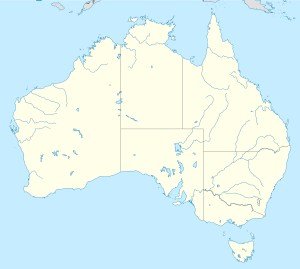West Gate Bridge
Coordinates: 37 ° 49 ′ 47 ″ S , 144 ° 53 ′ 54 ″ E
| West Gate Bridge | ||
|---|---|---|
| use | Vehicular traffic | |
| Crossing of | Yarra River | |
| place | Melbourne | |
| construction | Cable- stayed bridge with steel box girder and orthotropic deck | |
| overall length | 2582.4 m | |
| width | 37.2 m | |
| Longest span | 336 m | |
| height | 58 m | |
| vehicles per day | 165,000 | |
| building-costs | 202 million AUD | |
| opening | November 15, 1978 | |
| location | ||
|
|
||
The West Gate Bridge is a cable-stayed bridge in Melbourne . It spans the Yarra River just before its mouth in Port Phillip and connects the city center with the industrial areas in the west of the city. The West Gate Bridge is the third longest bridge in Australia: with a total length of 2582.6 m, it is twice as long as the Sydney Harbor Bridge . The longest span is 336 m, the height above the Yarra 58 m.
traffic
The bridge has four lanes in each direction and is used by around 165,000 vehicles every day. Pedestrians and cyclists are not allowed to use the structure. A ferry is available for them, which runs on demand during the week during peak traffic times and runs all day on weekends and public holidays.
history
The first plans for a bridge near the mouth of the Yarra were made in 1957. The rapid development of Melbourne made a new crossing of the river necessary to accommodate the additional traffic. In 1966 work began with the first test drilling . The end of the construction work was scheduled for the end of 1970.
accident
On October 15, 1970 at 11:50 am, the 112 m long bridge girder between piers 10 and 11 failed. It fell into the river and onto the bank area, killing 35 workers. The part that did not fall into the water fell straight onto the workers' quarters, where many workers were staying during the lunch break. Some fatalities were on or in the box girder during the accident . The impact of the 2000 t heavy segment rocked buildings several hundred meters away.
A faulty construction and the unusual procedure during construction were identified as the cause of the accident . The segments for the box girder were created in two halves on the floor, lifted into position and screwed together. On the day of the accident, the two half-segments could not be screwed together because one was preloaded 11.4 cm higher than the other due to an assembly error. It was decided to load the higher segment with 80 t, which was achieved by placing 10 concrete blocks. Under the additional weight, the half-segment began to deform and bumps appeared. When the longitudinal screwing of the two segment halves was partially completed, the order was given to remove the dents. After some of the screws were loosened again, overloaded components failed and caused the girder to collapse.
Today the West Gate Bridge Memorial commemorates the workers who were killed in the disaster.
The bridge was completed in 1978 as part of the West Gate Freeway after ten years of construction . The construction costs amounted to 202 million AUD and should be offset by a toll , which was abolished in 1985.
future
Because of the increasing traffic in Melbourne there are considerations to widen the bridge, to create a tunnel under the river or to provide the bridge with a second level. The decision was made to open five lanes in one direction and three in the other at peak times. In 2006, plans became known that a tunnel would be built to relieve the bridge.
literature
- Royal Commission: Failure of West Gate Bridge . Melbourne 1971 ( pdf ).
Web links
- The West Gate Bridge Memorial. West Gate Bridge Memorial Committee, 2013, accessed on September 22, 2013 (English, page of the committee responsible for the memorial to the disaster.).


